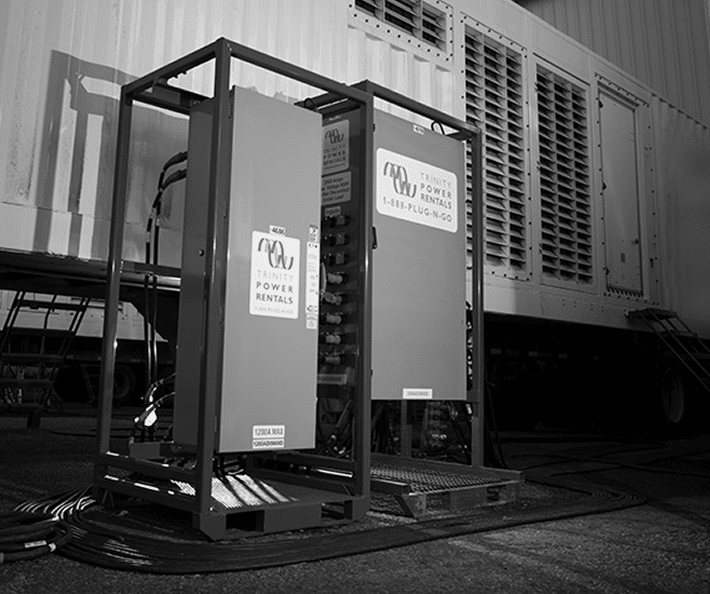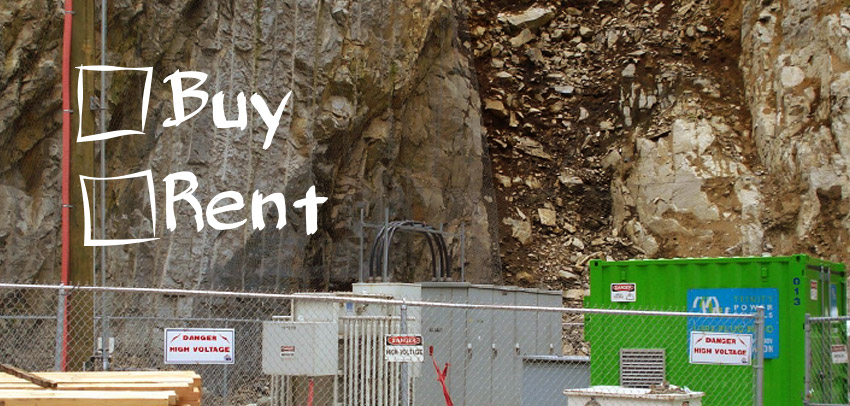- OUR APPROACH
-
COMMITTED TO YOUR SUCCESS
Our approach, developed over decades of experience, is fine-tuned to get the results you want.
We deliver concept-to-completion solutions, designed by temporary power specialists with access to the largest inventory of high-quality power generation and distribution equipment in North America.
-
- Equipment
-
RENTALS
From a wide range of diesel and natural gas generators to transformers, cable, light towers and more, our large rental fleet and extensive vendor network ensure we’ll have the temporary power equipment that your project requires — every time.

-
- Industries
-
INDUSTRIES WE SERVE
For nearly 20 years, we have been at work powering projects across Canada’s industrial sectors.
Select from this sampling of industries to learn how we can put our expertise to work for you.
VIEW ALL- Projects
- About
-
A PROUD HISTORY. A BRIGHT FUTURE.
From our inception in 1998, we have been building our team on a foundation of excellence. Our team members’ passion, expertise and commitment are what have allowed us to grow into a national company with projects across Canada.
Click on the links to learn more about our history, our team or our career opportunities.
- Blog
- Contact
-
When it comes to temporary power, the big equipment often steals the show. It’s shiny, it’s powerful. It rolls off the truck in a flurry of activity, ready to save the day, or get the project started. But for that equipment to work, it has to be connected. Cables and distribution equipment might not be as sexy as big generators but they are just as important. And for temporary power applications, one type of equipment stands above the crowd: it’s called PLUG-N-GO and it can save your project time, money and man-hours-at-risk.
But what is PLUG-N-GO distribution equipment, and how, exactly, is it the perfect piece of your temporary power system puzzle?
We’ve spoken with Trinity expert Nick Foster and Mike Paone, owner of Paone Electric, to help explain.
What is PLUG-N-GO?
“PLUG-N-GO is essentially allowing cable to run and be connected without making connections within the equipment,” explains Foster. This means that instead of cutting wires, soldering and creating fixed connections between cables and equipment, the cable can be plugged in, like a large, rugged home appliance. Camlok, pin and sleeve, twist-lock are all examples of PLUG-N-GO connection types.
PLUG-N-GO cable is also more flexible and lighter than tech cable, which has multiple conductors and casings.
Paone Electric provides electrical services for industrial and construction PLUG-N-GO is the go-to on temporary power projects. “For temporary power, I use PLUG-N-GO. I haven’t used anything else,” he explains.
Improve Safety and Reduce Man-Hours-At-Risk
One of the draws of PLUG-N-GO equipment is that it’s safe to use. Says Paone, “We haven’t had any safety issues — it’s a safe way to go.” Paone describes a project that involved bringing electrical equipment inside a large underground water reservoir. “It was like a football field underground,” he recalls, “and they were refinishing it. They needed temporary lighting and they needed power for the equipment.”
Paone’s team brought the equipment down, including around 800 feet of cable and five tabletop power distribution points. Despite the damp conditions, the project went smoothly, and the equipment performed reliably and safely.
But other cable can perform in wet conditions as well. What puts PLUG-N-GO a step above?
The answer lies in man-hours-at-risk. “Terminating in the transformer – those are man-hours-at-risk,” explains Foster. “You’re using a knife, you’re working with your hands inside an enclosure.”
PLUG-N-GO eliminates the risk of injury associated with cutting cable on site. This, in turn, reduces a company’s man-hours-at-risk for the project, leading to safer workers and a cleaner project timeline .
Save Time
An obvious benefit of PLUG-N-GO’s simplicity is that it saves time. “You take a cable, you put it in and you twist it 180 degrees, and then that’s your connection,” says Foster. “It takes 45 seconds compared to when I was back working in the field and it would take me a day to terminate a transformer.” But renting PLUG-N-GO equipment from a vendor like Trinity Power means that that work has already been done. “All those internal connections are done in our shop, so it’s a quick install.”
Because it’s so quick to install, Paone uses PLUG-N-GO for emergency outages as well. “It’s quicker,” he says. “The cable is flexible. You just roll it out, and connect it to the distribution at one end and the generator at the other.”
Keep Costs Low
As is so often the case, the efficiency and safety of PLUG-N-GO equipment has a direct impact on costs.
“Obviously there’s cost savings with being quicker on site, allowing those installs and getting back up and operational faster,” says Foster. Adding to that is how easy PLUG-N-GO cable is to move around. Foster explains, “With tech cable, that cable is cut; it’s too short, or it’s longer, and you can’t move it. With PLUG-N-GO, you can disconnect the unit, add another 50 feet of cable and be back up and running within an hour.”
Cost savings can also be found in the reduction of man-hours-at-risk that this equipment provides.
Whether or not speed and safety are priorities for your project, it all comes down to the bottom line. For nearly any temporary power application, PLUG-N-GO is going to improve safety, reduce time, and as a result, keep your budget happy.
As Paone says, “It’s safe, it’s easy to use, it’s quick.”
Related Articles
Subscribe for Access to Exclusive Content
Get insider updates, industry news, special equipment offers, and expert tips—directly to your inbox.
"*" indicates required fields




















